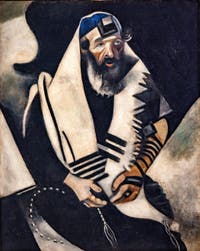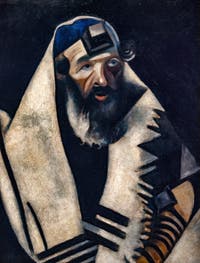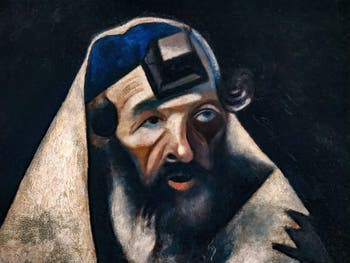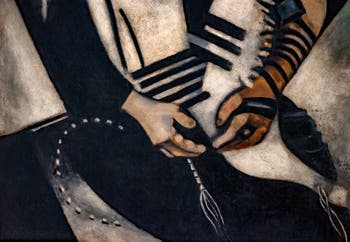Ca' Pesaro Artists | Location | Opening Hours Tickets | Authorizations
Artists Klimt | Chagall | Schiele | Bourdelle | Redon | Lichtenstein | Ensor | Wildt
Marc Chagall “Rabbi of Vitebsk” Ca' Pesaro International Modern Art Gallery in Venice Italy

Rabbi of Vitebsk Painting - Oil on Canvas (104 x 84cm) 1914-1922
This soft and moving canvas was painted between 1914 and 1922 during Chagall's stay in Russia, in his hometown of Vitebsk (now Belarus); hence it has been named “Rabbi of Vitebsk”.
Returning to Russia in 1914, Chagall thought he would stay there only a few months, but the First World War, followed by the Russian Revolution, forced him to remain in Russia until 1922.
In 1915 he married Bella Rosenfeld, his fiancée he met again in Vitebsk, who gave birth to their daughter Ida on May 18, 1916.
During his stay in Vitebsk, he became Commissioner of Fine Arts.

Rabbi of Vitebsk He founded an academy, the Institute for Art Nouveau, which had teachers Kazimir Malevich, Jean Pougny and Lazarus Lissitzky.
But the current of the “Suprematists”, led by Malevich, took advantage of Chagall's stay in Moscow to squeeze him out of the direction of his Academy of Art, whose new director was... Malevich.
Chagall decided to leave Vitebsk for Moscow permanently.
Let us return to the “Rabbi of Vitebsk” a painting that perfectly represents Marc Chagall's revival with his Jewish roots in his hometown.
This painting's real subject is not a rabbi but a man in prayer.
The model chosen by Chagall was a simple wanderer, a wandering Jew, who posed with the clothes and prayer objects that belonged to the artist's father.

Rabbi of Vitebsk We understand that it also shows his father, who prayed every morning, that Chagall wanted to represent here.
This praying man wears a blue kippa and two tefillin (or phylacteries) tied by leather straps on his forehead and left arm.
Tefillin are small square boxes that contain a piece of parchment on which Torah's verses are written.
He also wears the ritual shawl lined with fringes whose Jews cover their shoulders during prayer.
These religious elements are used wonderfully in this canvas to create powerful contrasts of colours (white and black were considered true colours by Chagall) highlighted by geometric shapes reminiscent of cubism.

Rabbi of Vitebsk Let's end with a portrait of Chagall, written by Blaise Cendrars:
“He sleeps
He's awake
Suddenly, he paints
He takes a church and painted with the church
He takes a cow and painted with a cow
With a sardine
With heads, hands, knives...”
Blaise Cendrars - 19 elastic poems, Portrait of Chagall 1919.
Artists Klimt | Chagall | Schiele | Bourdelle | Redon | Lichtenstein | Ensor | Wildt
Ca' Pesaro Artists | Location | Opening Hours Tickets | Authorizations
Back to Top of Page

